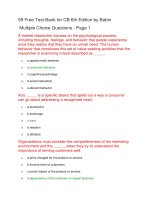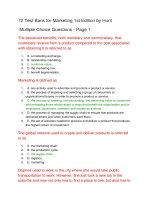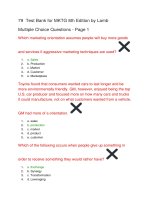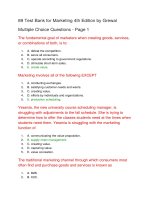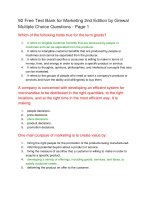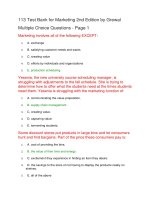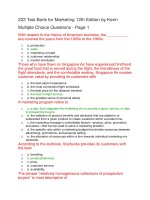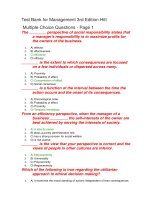Test bank for management 3rd edition by hitt
Bạn đang xem bản rút gọn của tài liệu. Xem và tải ngay bản đầy đủ của tài liệu tại đây (124.36 KB, 29 trang )
Full file at />
Management, 3e (Hitt)
Chapter 1 The Nature of Management
1) Management is the process of assembling and using sets of resources in a goal-directed
manner to accomplish tasks in an organizational setting.
Answer: TRUE
Page Ref: 4
Difficulty: Easy
Classification: Conceptual
Objective: 1
2) In the context of an organization, all managers are members but all members are not
managers.
Answer: TRUE
Page Ref: 4
Difficulty: Easy
Classification: Conceptual
Objective: 1
3) Managing change becomes difficult for managers because employees tend to resist change.
Answer: TRUE
Page Ref: 5
Difficulty: Easy
Classification: Conceptual
Objective: 2
4) The growth of the Internet has increased the importance of human capital.
Answer: TRUE
Page Ref: 5
Difficulty: Easy
Classification: Conceptual
Objective: 2
5) Global events have little effect on the goals that managers set, the decisions they make, and
how they coordinate and lead the work of other people.
Answer: FALSE
Page Ref: 5
Difficulty: Easy
Classification: Conceptual
Objective: 2
buy this full document at
Full file at />
6) A manager's interpersonal and communication skills are essential to the process of allocating
and coordinating resources to accomplish the required tasks of an organization.
Answer: TRUE
Page Ref: 6-7
Difficulty: Easy
Classification: Conceptual
Objective: 2
7) A firm's reputation and its employees are both tangible resources.
Answer: FALSE
Page Ref: 8
Difficulty: Easy
Classification: Conceptual
Objective: 2
8) An entrepreneurial mind-set allows a manager to assess uncertainty and take action to exploit
any possible opportunities.
Answer: TRUE
Page Ref: 9
Difficulty: Easy
Classification: Conceptual
Objective: 2
9) Frederick Taylor, who is credited to be the "father of modern management," believed that
employees are primarily motivated by pay.
Answer: FALSE
Page Ref: 10
Difficulty: Easy
Classification: Conceptual
Objective: 3
10) Planning involves estimating future conditions and circumstances, and based on these
estimations, making decisions about the work of the manager and for all employees for whom
she or he is responsible.
Answer: TRUE
Page Ref: 11
Difficulty: Easy
Classification: Conceptual
Objective: 4
11) Controlling is important but not a necessary managerial function.
Answer: FALSE
Page Ref: 13
Difficulty: Easy
Classification: Conceptual
Objective: 4
buy this full document at
Full file at />
12) Evaluating employee performance on completed tasks is not a part of controlling.
Answer: FALSE
Page Ref: 13
Difficulty: Easy
Classification: Conceptual
Objective: 4
13) Mintzberg's typology of managerial roles entails three major categories: planning, directing,
and controlling.
Answer: FALSE
Page Ref: 13
Difficulty: Easy
Classification: Conceptual
Objective: 5
14) A marketing manager is acting as a figurehead when he or she interacts with key customers
to learn about their reactions to new product ideas.
Answer: FALSE
Page Ref: 13
Difficulty: Easy
Classification: Conceptual
Objective: 5
15) According to Mintzberg, the informational roles of a manager are derived from the network
of contacts that he or she has built up and maintained.
Answer: FALSE
Page Ref: 14
Difficulty: Easy
Classification: Conceptual
Objective: 5
16) In Mintzberg's management model, the negotiator role often requires managers to make
accommodations with other units or other organizations.
Answer: TRUE
Page Ref: 16
Difficulty: Easy
Classification: Conceptual
Objective: 5
17) Decisional roles are relatively unimportant in managerial responsibilities.
Answer: FALSE
Page Ref: 16
Difficulty: Easy
Classification: Conceptual
Objective: 5
buy this full document at
Full file at />
18) As the general manager of a steel plant, Frederick Ivanovic has to divide his time between
supervising the overall functioning of the plant, resolving conflicts between workers, preparing
production reports, and meeting with his seniors to provide them with regular updates. This
reflects the constraint dimension of management.
Answer: FALSE
Page Ref: 18
Difficulty: Easy
Classification: Application
Objective: 6
AACSB: Analytic skills
19) Technical skills involve specialized knowledge about procedures, processes, and equipment
and the related abilities of knowing when and how to use that knowledge.
Answer: TRUE
Page Ref: 19
Difficulty: Easy
Classification: Conceptual
Objective: 7
20) A manager's interpersonal skills include empathy, persuasiveness, and sensitivity.
Answer: TRUE
Page Ref: 19
Difficulty: Easy
Classification: Conceptual
Objective: 7
21) Conceptual skills - such as logical reasoning, judgment, and analytical abilitiesre
aa strong
predictor of managerial effectiveness.
Answer: TRUE
Page Ref: 20
Difficulty: Easy
Classification: Conceptual
Objective: 7
22) ________ is the process of assembling and using sets of resources in a goal-directed manner
to accomplish tasks in an organization.
A) Accounting
B) Management
C) Budgeting
D) Planning
Answer: B
Page Ref: 4
Difficulty: Easy
Classification: Conceptual
Objective: 1
buy this full document at
Full file at />
23) In the context of an organization, members are defined as ________.
A) the nonmanagerial employees
B) all employees
C) the group of rank-and-file employees
D) members of the labor union
Answer: B
Page Ref: 4
Difficulty: Easy
Classification: Conceptual
Objective: 1
24) In the context of an organization, identify the correct statement from the following.
A) All members are, by definition, parts of collective bargaining units.
B) Union is synonymous with collective bargaining units.
C) All those who are not involved in specific managerial activities must be members of the
union.
D) The term member refers to all employees of the organization.
Answer: D
Page Ref: 4
Difficulty: Easy
Classification: Conceptual
Objective: 1
25) The term ________ refers to any person in an organization without regard to that individual's
role in it.
A) management
B) member
C) manager
D) union
Answer: B
Page Ref: 4
Difficulty: Easy
Classification: Conceptual
Objective: 1
26) The term manager refers to anyone who ________.
A) is not a member of a labor union
B) is a member of an organization
C) owns shares in the company
D) plans, controls, and evaluates
Answer: D
Page Ref: 4
Difficulty: Easy
Classification: Conceptual
Objective: 1
buy this full document at
Full file at />
27) Which of the following statements is true regarding change in an organization?
A) New managers are usually not expected to create change.
B) Managing change is a lengthy but straightforward task.
C) If employees are resistent to change, the only option left with a manager is to enforce it
forcibly.
D) Managers must face the need for change and the opportunity to create change.
Answer: D
Page Ref: 5
Difficulty: Easy
Classification: Conceptual
Objective: 2
28) The development of new technologies has ________.
A) increased the speed of change implementation
B) reduced the importance of skilled labor
C) restricted the flow of information
D) reduced the time-horizon of strategic planning
Answer: A
Page Ref: 5
Difficulty: Easy
Classification: Conceptual
Objective: 2
29) Which one of the following statements is true about the effects of the Internet on how
managers do their jobs?
A) The importance of knowledge has declined.
B) The Internet has reduced the amount of competition in all markets.
C) It offers new ways of accomplishing tasks.
D) It has decreased the importance of entrepreneurs.
Answer: C
Page Ref: 5
Difficulty: Easy
Classification: Conceptual
Objective: 2
30) Which of the following statements about globalization is NOT true?
A) Globalization opens new markets and increases competition.
B) Globalization promotes greater involvement in international markets.
C) Globalization affects the goals, decisions, and responsibilities of managers.
D) Globalization affects large businesses but seldom impacts small businesses.
Answer: D
Page Ref: 5-6
Difficulty: Easy
Classification: Conceptual
Objective: 2
buy this full document at
Full file at />
31) Effective managers ________.
A) accept existing resource limits and levels of employee motivation
B) use resources to maximize the achievement of the organization's goals
C) prefer working alone rather than with groups or other individuals
D) let subordinates evaluate people's skills before selecting the best candidate
Answer: B
Page Ref: 6
Difficulty: Easy
Classification: Conceptual
Objective: 2
32) Managers at ________ establish goals and formulate a strategy for the firm to achieve those
goals.
A) the top of the organization
B) all levels of the organization
C) operational levels of the organization
D) functional levels of the organization
Answer: A
Page Ref: 8
Difficulty: Easy
Classification: Conceptual
Objective: 2
33) When forming the strategy of the major units within an organization, managers should
________.
A) not focus on the human factor
B) be innovative and entrepreneurial
C) assume that conditions will remain stable
D) focus only on existing opportunities
Answer: B
Page Ref: 9
Difficulty: Easy
Classification: Conceptual
Objective: 2
34) Managers who have an entrepreneurial mind-set ________.
A) resist uncertainty and maintain the status quo
B) are found only at the top-level of the organizational hierarchy
C) are alert to new ideas and use them to create value for customers
D) usually avoid risky ventures
Answer: C
Page Ref: 9
Difficulty: Easy
Classification: Conceptual
Objective: 2
buy this full document at
Full file at />
35) What is the primary legacy of Frederick Taylor?
A) the concept of employee motivation
B) the principles of scientific management
C) the "hierarchy of needs" theory
D) the concept of job enrichment
Answer: B
Page Ref: 10
Difficulty: Easy
Classification: Conceptual
Objective: 3
36) Which of the following views is consistent with Frederick Taylor's theory?
A) Workers are most motivated by pay.
B) The management should link workers' incentives to their performance.
C) The management should bear in mind that workers function better when tasks are clearly
assigned.
D) Workers are best motivated by autonomy.
Answer: B
Page Ref: 10
Difficulty: Easy
Classification: Conceptual
Objective: 3
37) Douglas McGregor is best known for promoting ________ leadership practices in which
positive leadership can bring forth greater efforts and levels of achievement from employees.
A) Theory Y
B) Theory X
C) ERG theory
D) Theory Z
Answer: B
Page Ref: 10
Difficulty: Easy
Classification: Conceptual
Objective: 3
38) ________ involves estimating future conditions and circumstances and making decisions
based on these estimations.
A) Directing
B) Controlling
C) Organizing
D) Planning
Answer: D
Page Ref: 11
Difficulty: Easy
Classification: Conceptual
Objective: 4
buy this full document at
Full file at />
39) ________ translates long-term plans into actions designed to achieve specific and shorterterm goals and objectives.
A) Operational planning
B) Strategic planning
C) Tactical planning
D) Transactional planning
Answer: C
Page Ref: 11
Difficulty: Easy
Classification: Conceptual
Objective: 4
40) Sarah is the business manager of a company manufacturing shoes. After a successful stint in
the shoe industry, she begins to consider the viability of expanding the business to the leather bag
industry. This is an example of ________.
A) strategic planning
B) functional planning
C) operational planning
D) tactical planning
Answer: A
Page Ref: 11
Difficulty: Moderate
Classification: Application
Objective: 4
41) Scott is the business head of a software development firm that wants to increase its market
share to 30 percent in the next 5 years. The company feels that the best way to go about this is to
acquire smaller firms that have a promising talent pool. In his capacity as a business head, Scott
is required to plan how the company will arrange for the necessary finances for these
acquisitions. Scott is engaging in ________ for the firm.
A) operational planning
B) product planning
C) tactical planning
D) strategic planning
Answer: C
Page Ref: 11
Difficulty: Moderate
Classification: Application
Objective: 4
AACSB: Analytic skills
buy this full document at
Full file at />
42) ________ identifies the actions needed to accomplish the goals of particular units of the
organization or particular product lines in their respective markets.
A) Directional planning
B) Tactical planning
C) Strategic planning
D) Operational planning
Answer: D
Page Ref: 11
Difficulty: Easy
Classification: Conceptual
Objective: 4
43) Of the four major functions of a manager, ________ involves systematically integrating
resources to accomplish tasks.
A) organizing
B) directing
C) planning
D) auditing
Answer: A
Page Ref: 11
Difficulty: Easy
Classification: Conceptual
Objective: 4
44) Of the four major functions of a manager, the purpose of ________ at the most basic level is
the attempt to bring order to the organization.
A) directing
B) organizing
C) auditing
D) feedback
Answer: B
Page Ref: 11
Difficulty: Easy
Classification: Conceptual
Objective: 4
45) The managerial function of ________ is the process of attempting to influence other people
to attain the objectives of an organization.
A) directing
B) planning
C) auditing
D) organizing
Answer: A
Page Ref: 11
Difficulty: Easy
Classification: Conceptual
Objective: 4
buy this full document at
Full file at />
46) Which of the following is true about the principal managerial functions applicable to modern
organizations?
A) Organizing involves strategic and tactical planning.
B) Planning involves identifying the appropriate structure of relationships among positions and
the people occupying them.
C) Directing involves leading and motivating those for whom the manager is responsible.
D) Controlling employee behavior is easier for a manager from the middle level management.
Answer: C
Page Ref: 11
Difficulty: Easy
Classification: Conceptual
Objective: 4
47) The managerial function of ________ is regulating the work of those for whom a manager is
responsible.
A) directing
B) controlling
C) planning
D) auditing
Answer: B
Page Ref: 13
Difficulty: Easy
Classification: Conceptual
Objective: 4
48) Among many other responsibilities, Angela Morrison also manages two research teams at a
market research firm. Team leaders from both report to her and give her regular updates on how
the work is progressing. She carefully monitors the performance of both teams and gives them
regular feedback on their work. This is an example of ________.
A) auditing
B) controlling
C) organizing
D) planning
Answer: B
Page Ref: 13
Difficulty: Easy
Classification: Application
Objective: 4
AACSB: Analytic skills
buy this full document at
Full file at />
49) ________ roles of a manager are composed of the figurehead role, the leader role, and the
liaison role.
A) Informational
B) Decisional
C) Interpersonal
D) Negotiator
Answer: C
Page Ref: 13
Difficulty: Easy
Classification: Conceptual
Objective: 5
50) Acting as a figurehead involves ________.
A) influencing or directing others
B) extensive information seeking
C) attending or participating in ceremonial activities
D) contacts with persons outside the formal chain of command
Answer: C
Page Ref: 13
Difficulty: Easy
Classification: Conceptual
Objective: 5
51) As the regional manager of an accounting firm, Ruth is often required to attend ceremonial
activities like attending a social function on behalf of the company or presiding at a farewell
dinner of a departing employee. Which of the following is similar to the given scenario?
A) As a marketing manager, Aaron's accountability to the firm lies in seeking extensive
information and remaining aware of crucial developments in the industry.
B) One of Naomi's responsibilities as a manager is to build contacts with important officials
within and outside the industry.
C) As the dean of a business school, Jack is always present at official functions like
commencement ceremonies and convocations to give away diplomas.
D) In his capacity as a manager, Dave is often required to solve conflicts within the organization.
Answer: C
Page Ref: 13
Difficulty: Moderate
Classification: Critical Thinking
Objective: 5
AACSB: Reflective thinking skills
buy this full document at
Full file at />
52) As the dean of a business school, Mike is often required to participate in activities such as the
inauguration of a new faculty or delivering a welcoming address at a seminar hosted by the
college. He is most likely playing the ________ role as a member of the college management.
A) liaison
B) leader
C) disseminator
D) figurehead
Answer: D
Page Ref: 13
Difficulty: Moderate
Classification: Application
Objective: 5
AACSB: Analytic skills
53) The ________ role of a manager involves influencing or directing others.
A) liaison
B) leader
C) figurehead
D) monitor
Answer: B
Page Ref: 14
Difficulty: Easy
Classification: Conceptual
Objective: 5
54) Matt is known to have substantial influence over his team. He has regular meetings with
them to ensure that they do not lose sight of what they are trying to accomplish. He also
motivates them to set challenging targets for themselves and achieve those targets. What role is
Matt playing?
A) the figurehead role
B) the monitor role
C) the negotiator role
D) the leader role
Answer: D
Page Ref: 14
Difficulty: Moderate
Classification: Application
Objective: 5
AACSB: Analytic skills
buy this full document at
Full file at />
55) Which of the following roles is an interpersonal role?
A) negotiator
B) spokesperson
C) leader
D) disturbance handler
Answer: C
Page Ref: 14
Difficulty: Easy
Classification: Conceptual
Objective: 5
56) The ________ role emphasizes a manager's contacts with those outside the formal chain of
command.
A) liaison
B) monitor
C) disseminator
D) resource allocator
Answer: A
Page Ref: 14
Difficulty: Easy
Classification: Conceptual
Objective: 5
57) Bianca is the marketing manager of a company that develops software. She interacts with
key clients to learn about their reactions to new product ideas. What managerial role is Bianca
playing here?
A) She is playing the role of an entrepreneur.
B) She is playing the role of a leader.
C) She is playing the role of a liaison.
D) She is playing the role of a figurehead.
Answer: C
Page Ref: 14
Difficulty: Moderate
Classification: Application
Objective: 5
AACSB: Analytic skills
buy this full document at
Full file at />
58) Which of the following types of managerial roles includes acting as a monitor, disseminator,
and a spokesperson?
A) decisional roles
B) informational roles
C) interpersonal roles
D) liaison roles
Answer: B
Page Ref: 14
Difficulty: Easy
Classification: Conceptual
Objective: 5
59) The ________ role involves extensive information seeking in which managers engage to
remain aware of crucial developments that may affect their units and their own work.
A) disturbance handler
B) monitor
C) entrepreneurial
D) spokesperson
Answer: B
Page Ref: 14
Difficulty: Easy
Classification: Conceptual
Objective: 5
60) As the manager of a waste recycling company, Ruth has been asked to attend a seminar on
green living. At the seminar, she spends considerable time interacting with her colleagues from
the industry and discussing the various events and innovations that are taking place. Ruth feels it
is extremely important for her to remain updated with the developments in the industry. She is
playing the ________ role.
A) liaison
B) monitor
C) negotiator
D) entrepreneurial
Answer: B
Page Ref: 14
Difficulty: Moderate
Classification: Application
Objective: 5
AACSB: Analytic skills
buy this full document at
Full file at />
61) A manager in the ________ role not only receives information but also sends it.
A) entrepreneurial
B) negotiator
C) monitor
D) disseminator
Answer: D
Page Ref: 14
Difficulty: Easy
Classification: Conceptual
Objective: 5
62) Seth is required to make quarterly presentations to the firm's senior management on how the
resources allocated to his department are being utilized. He also provides a regular update on the
work done by his department. What managerial role does Seth play in this example?
A) disseminator
B) liaison
C) monitor
D) spokesperson
Answer: A
Page Ref: 14
Difficulty: Moderate
Classification: Application
Objective: 5
AACSB: Analytic skills
63) Which of the following is an informational role?
A) negotiator
B) leader
C) disseminator
D) entrepreneurial
Answer: C
Page Ref: 14
Difficulty: Easy
Classification: Conceptual
Objective: 5
64) When a manager is frequently called upon to represent the views of the unit for which he or
she is responsible, he/she is said to be fulfilling the ________ role.
A) entrepreneurial
B) spokesperson
C) monitor
D) negotiator
Answer: B
Page Ref: 15
Difficulty: Easy
Classification: Conceptual
Objective: 5
buy this full document at
Full file at />
65) In his capacity as the regional production manager, Mark Brown is required to address the
regional heads from across the country in a quarterly meeting organized by his company. At this
meeting, Mark presents the detailed production figures of his region and also outlines the
changes he plans to implement in order to improve productivity. Mark is playing the role of a
________.
A) monitor
B) disturbance handler
C) spokesperson
D) negotiator
Answer: C
Page Ref: 15
Difficulty: Moderate
Classification: Application
Objective: 5
AACSB: Analytic skills
66) Managers in the ________ role not only make routine decisions in their jobs but also
frequently engage in activities that explore new opportunities or start new projects.
A) liaison
B) monitor
C) negotiator
D) entrepreneurial
Answer: D
Page Ref: 15
Difficulty: Easy
Classification: Conceptual
Objective: 5
67) According to Mintzberg's theory of managerial functions, ________ roles include acting as
an entrepreneur, a disturbance handler, a resource allocator, and a negotiator.
A) decisional
B) informational
C) interpersonal
D) leader
Answer: A
Page Ref: 15-16
Difficulty: Easy
Classification: Conceptual
Objective: 5
buy this full document at
Full file at />
68) Naomi, a production manager at Morrison Textiles, comes up with a new technique of
enhancing worker productivity. She talks about this with her colleagues and friends, and
following positive responses from them, decides to take it up with the firm's senior management.
Naomi's effort to see this through reflects the ________ role that managers play.
A) negotiator
B) leadership
C) entrepreneurial
D) spokesperson
Answer: C
Page Ref: 15
Difficulty: Moderate
Classification: Application
Objective: 5
AACSB: Analytic skills
69) In the ________ role, managers who initiate actions of their own must also respond to
problems.
A) monitoring
B) disturbance handler
C) spokesperson
D) resource allocator
Answer: B
Page Ref: 16
Difficulty: Easy
Classification: Conceptual
Objective: 5
70) Jessica and Alex have been unable a decide who should do the team's work scheduling for
the next one month, a task that is both complex and time consuming. As their manager, Melanie
intervenes and tells them to jointly draw up the next month's production schedule. Melanie is
playing the role of a ________.
A) negotiator
B) resource allocator
C) liaison
D) disturbance handler
Answer: D
Page Ref: 16
Difficulty: Moderate
Classification: Application
Objective: 5
AACSB: Analytic skills
buy this full document at
Full file at />
71) Monica, who is the manager of front desk services at Lincoln Inn, decides how many and
which clerks to assign to each shift. She is performing the ________ role.
A) spokesperson
B) figurehead
C) disturbance handler
D) resource allocator
Answer: D
Page Ref: 16
Difficulty: Moderate
Classification: Application
Objective: 5
AACSB: Analytic skills
72) When managers are called upon to make accommodations with other units or other
organizations, they are functioning in the ________ role.
A) figurehead
B) negotiator
C) spokesperson
D) liaison
Answer: B
Page Ref: 16
Difficulty: Easy
Classification: Conceptual
Objective: 5
73) Which of the following roles is a decisional role?
A) spokesperson
B) monitor
C) negotiator
D) disseminator
Answer: C
Page Ref: 16
Difficulty: Easy
Classification: Conceptual
Objective: 5
buy this full document at
Full file at />
74) According to Rosemary Stewart, ________ involve(s) activities or duties that must be
accomplished and standards or levels of minimum performance that must be met.
A) constraints
B) planning
C) demands
D) choices
Answer: C
Page Ref: 18
Difficulty: Easy
Classification: Conceptual
Objective: 6
75) According to Rosemary Stewart's dimensions of managerial jobs, within which of the
following job dimensions is a manager working when he/she adheres to deadlines and follows
established procedures?
A) choices
B) constraints
C) demands
D) techniques
Answer: C
Page Ref: 18
Difficulty: Easy
Classification: Conceptual
Objective: 6
76) As the CEO of a software company, Keith is required to participate in several meetings each
week. Some of his other responsibilities include helping to formulate the company's strategic
plans and giving the final word on which projects the company will undertake. This reflects the
________ aspect of Keith's role as a manager.
A) constraint
B) demand
C) technique
D) compliance
Answer: B
Page Ref: 18
Difficulty: Moderate
Classification: Application
Objective: 6
AACSB: Analytic skills
buy this full document at
Full file at />
77) According to Rosemary Stewart's dimensions of managerial jobs, ________ are factors that
limit a manager's response to various demands.
A) constraints
B) choices
C) techniques
D) interpersonal skills
Answer: A
Page Ref: 18
Difficulty: Easy
Classification: Conceptual
Objective: 6
78) Technology and the attitudes of subordinates are considered to be the ________ of
managerial jobs.
A) requirements
B) demands
C) choices
D) constraints
Answer: D
Page Ref: 18
Difficulty: Easy
Classification: Conceptual
Objective: 6
79) Derek, a manager at an insurance firm, instructs all subordinates to fill in a daily log of their
day's work. However, he finds that even after a week of instituting this new rule, most employees
are either reluctant to fill it or are taking the instruction far too lightly. This reluctance on the part
of the employees is an example of the ________ dimension of Derek's job as a manager.
A) demand
B) requirement
C) constraint
D) technique
Answer: C
Page Ref: 18
Difficulty: Moderate
Classification: Application
Objective: 6
AACSB: Analytic skills
buy this full document at
Full file at />
80) Which of the following is a typical managerial choice?
A) allocation of resources
B) attitudes of subordinates
C) scheduled deadlines
D) legal regulations
Answer: A
Page Ref: 18
Difficulty: Easy
Classification: Conceptual
Objective: 6
81) Daniel is the manager of a luxury resort in the Bahamas. It is his responsibility to ensure that
his subordinates do all that it takes to meet customer requirements and make their stays
memorable. As a result, when one of their major customers voiced his dissatisfaction with the
receptionist at the front desk, Daniel decided to change the receptionist's shift while the guest
was staying at the resort. His authority to make this change reflects the ________ aspect of a
manager's job.
A) choice
B) constraint
C) demand
D) compliance
Answer: A
Page Ref: 18
Difficulty: Moderate
Classification: Application
Objective: 6
AACSB: Analytic skills
82) Ensuring that a restaurant maintains an attractive appearance would reflect the ________ job
dimension for its manager.
A) constraint
B) choice
C) demand
D) technique
Answer: C
Page Ref: 18
Difficulty: Easy
Classification: Conceptual
Objective: 6
buy this full document at
Full file at />
83) ________ involve having specialized knowledge about procedures, processes, and
equipment.
A) Interpersonal skills
B) Technical skills
C) Conceptual skills
D) Verbal skills
Answer: B
Page Ref: 19
Difficulty: Easy
Classification: Conceptual
Objective: 7
84) ________ are important at all levels of the management, and a lack of these skills will
usually limit managerial advancement, even when other skills exist.
A) Conceptual skills
B) Technical skills
C) Interpersonal skills
D) Organizational skills
Answer: C
Page Ref: 20
Difficulty: Easy
Classification: Conceptual
Objective: 7
85) ________ skills, also known as cognitive complexity, are often the major factor that
determines who reaches the highest levels of the organization.
A) Interpersonal
B) Technical
C) Conceptual
D) Decision-making
Answer: C
Page Ref: 20
Difficulty: Easy
Classification: Conceptual
Objective: 7
buy this full document at
Full file at />
86) Rick was hired as the director of a company manufacturing refrigerators at a time when the
company was financially unstable. After analyzing the market carefully, Rick decided to change
their marketing strategy. Rick's sound judgment did the trick, and the company turned around
and became profitable within two years. What managerial skill did Rick show?
A) interpersonal skills
B) communication skills
C) technical skills
D) conceptual skills
Answer: D
Page Ref: 20
Difficulty: Moderate
Classification: Application
Objective: 7
AACSB: Analytic skills
87) What is the relationship between change and management?
Answer: Managing change is the most persistent, pervasive, and powerful challenge with which
all managers have to deal, regardless of the nature of their organization or its location. No matter
how new or experienced managers are, they will be confronted with both the need for change
and the opportunity to create change. Two of the major causes of change are new technology and
globalization.
Technological developments happen quickly and continuously; therefore, managers cannot
ignore the impact of technology on their jobs and their companies. For example, the Internet has
created opportunities for marketing products, reaching distant markets, transferring information,
and communicating internally and externally. Managers must identify and exploit these
opportunities. If they do not, then their competitors will.
Globalization involves the increasing international and cross-national nature of politics and
business. Global events affect the goals managers set, the decisions they make, and their efforts
to coordinate and lead the work of others. In addition, as their companies move into international
markets, managers must understand the cultures and institutional environments in these new
markets.
Page Ref: 5-6
Difficulty: Moderate
Classification: Conceptual
Objective: 1
buy this full document at
Full file at />
88) Why must managers have an entrepreneurial mind-set?
Answer: An entrepreneurial mind-set allows managers to search for new opportunities in the
current marketplace or identify ideas that could create new markets, to be committed to
continuous learning, as well as to identify new opportunities and to exploiting them.
Entrepreneurial activity is not limited to new, small firms, however. Managers in large firms also
must be entrepreneurial and strive to create new businesses. Developing new businesses requires
that the lead person, and perhaps others, take entrepreneurial actions. Given the amount of
change and innovation encountered in most industries and countries, businesses cannot survive
without being entrepreneurial.
Page Ref: 9
Difficulty: Moderate
Classification: Conceptual
Objective: 1
89) Identify and explain the four managerial functions.
Answer: The four principal managerial functions most applicable to modern organizations are
planning, organizing, directing, and controlling.
Planning involves estimating future conditions and circumstances and, based on these
estimations, making decisions about the work of the manager and for all employees for whom
she or he is responsible.
Organizing involves identifying the appropriate structure of relationships among positions, and
the people occupying them, and linking that structure to the overall strategic direction of the
organization.
Directing is the process of attempting to influence other people to attain the organization's
objectives. It heavily involves leading and motivating those for whom the manager is
responsible, interacting with them effectively in group and team situations, and communicating
in ways that acknowledge and support their efforts to accomplish tasks and achieve
organizational goals.
Controlling includes setting standards of performance for employees in advance, monitoring
ongoing (real-time) performance and, especially, assessing the performance of employees on
completed tasks.
Page Ref: 10-13
Difficulty: Easy
Classification: Conceptual
Objective: 4
buy this full document at
